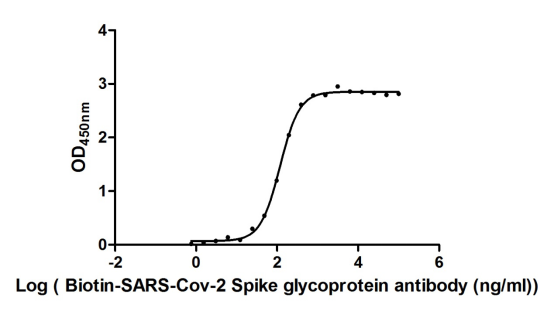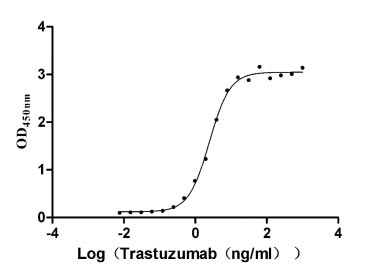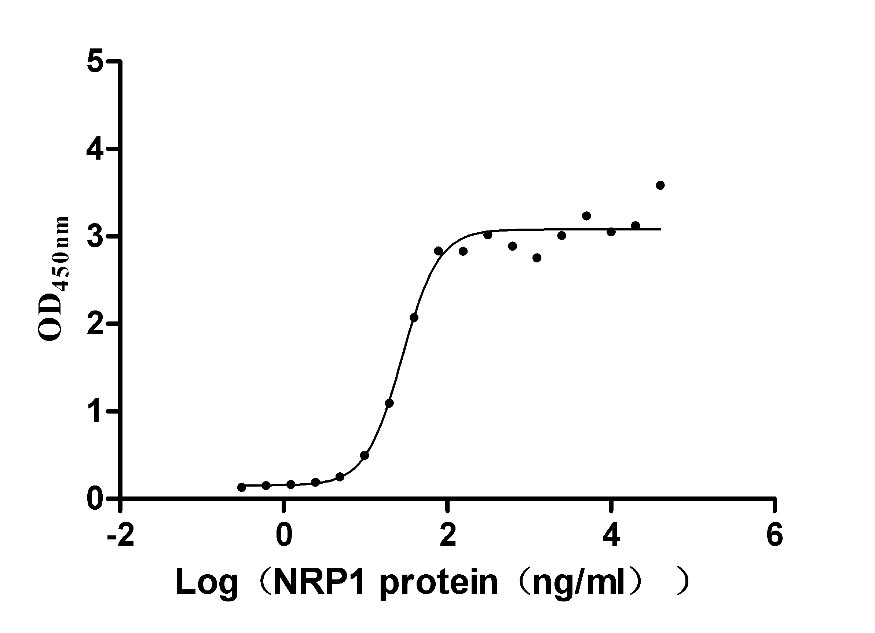Recombinant Mouse Protein lin-28 homolog A (Lin28a)
-
货号:CSB-YP812996MO
-
规格:
-
来源:Yeast
-
其他:
-
货号:CSB-EP812996MO
-
规格:
-
来源:E.coli
-
其他:
-
货号:CSB-EP812996MO-B
-
规格:
-
来源:E.coli
-
共轭:Avi-tag Biotinylated
E. coli biotin ligase (BirA) is highly specific in covalently attaching biotin to the 15 amino acid AviTag peptide. This recombinant protein was biotinylated in vivo by AviTag-BirA technology, which method is BriA catalyzes amide linkage between the biotin and the specific lysine of the AviTag.
-
其他:
-
货号:CSB-BP812996MO
-
规格:
-
来源:Baculovirus
-
其他:
-
货号:CSB-MP812996MO
-
规格:
-
来源:Mammalian cell
-
其他:
产品详情
-
纯度:>85% (SDS-PAGE)
-
基因名:Lin28a
-
Uniprot No.:
-
别名:Lin28a; Lin28; Tex17Protein lin-28 homolog A; Lin-28A; Testis-expressed protein 17
-
种属:Mus musculus (Mouse)
-
蛋白长度:Full Length of Mature Protein
-
表达区域:2-209
-
氨基酸序列GSVSNQQFA GGCAKAAEKA PEEAPPDAAR AADEPQLLHG AGICKWFNVR MGFGFLSMTA RAGVALDPPV DVFVHQSKLH MEGFRSLKEG EAVEFTFKKS AKGLESIRVT GPGGVFCIGS ERRPKGKNMQ KRRSKGDRCY NCGGLDHHAK ECKLPPQPKK CHFCQSINHM VASCPLKAQQ GPSSQGKPAY FREEEEEIHS PALLPEAQN
-
蛋白标签:Tag type will be determined during the manufacturing process.
The tag type will be determined during production process. If you have specified tag type, please tell us and we will develop the specified tag preferentially. -
产品提供形式:Lyophilized powder
Note: We will preferentially ship the format that we have in stock, however, if you have any special requirement for the format, please remark your requirement when placing the order, we will prepare according to your demand. -
复溶:We recommend that this vial be briefly centrifuged prior to opening to bring the contents to the bottom. Please reconstitute protein in deionized sterile water to a concentration of 0.1-1.0 mg/mL.We recommend to add 5-50% of glycerol (final concentration) and aliquot for long-term storage at -20℃/-80℃. Our default final concentration of glycerol is 50%. Customers could use it as reference.
-
储存条件:Store at -20°C/-80°C upon receipt, aliquoting is necessary for mutiple use. Avoid repeated freeze-thaw cycles.
-
保质期:The shelf life is related to many factors, storage state, buffer ingredients, storage temperature and the stability of the protein itself.
Generally, the shelf life of liquid form is 6 months at -20°C/-80°C. The shelf life of lyophilized form is 12 months at -20°C/-80°C. -
货期:Delivery time may differ from different purchasing way or location, please kindly consult your local distributors for specific delivery time.Note: All of our proteins are default shipped with normal blue ice packs, if you request to ship with dry ice, please communicate with us in advance and extra fees will be charged.
-
注意事项:Repeated freezing and thawing is not recommended. Store working aliquots at 4°C for up to one week.
-
Datasheet :Please contact us to get it.
靶点详情
-
功能:RNA-binding protein that inhibits processing of pre-let-7 miRNAs and regulates translation of mRNAs that control developmental timing, pluripotency and metabolism. Seems to recognize a common structural G-quartet (G4) feature in its miRNA and mRNA targets. 'Translational enhancer' that drives specific mRNAs to polysomes and increases the efficiency of protein synthesis. Its association with the translational machinery and target mRNAs results in an increased number of initiation events per molecule of mRNA and, indirectly, in mRNA stabilization. Binds IGF2 mRNA, MYOD1 mRNA, ARBP/36B4 ribosomal protein mRNA and its own mRNA. Essential for skeletal muscle differentiation program through the translational up-regulation of IGF2 expression. Suppressor of microRNA (miRNA) biogenesis, including that of let-7, miR107, miR-143 and miR-200c. Specifically binds the miRNA precursors (pre-miRNAs), recognizing an 5'-GGAG-3' motif found in pre-miRNA terminal loop, and recruits TUT4 and TUT7 uridylyltransferaseS. This results in the terminal uridylation of target pre-miRNAs. Uridylated pre-miRNAs fail to be processed by Dicer and undergo degradation. The repression of let-7 expression is required for normal development and contributes to maintain the pluripotent state by preventing let-7-mediated differentiation of embryonic stem cells. Localized to the periendoplasmic reticulum area, binds to a large number of spliced mRNAs and inhibits the translation of mRNAs destined for the ER, reducing the synthesis of transmembrane proteins, ER or Golgi lumen proteins, and secretory proteins. Binds to and enhances the translation of mRNAs for several metabolic enzymes, such as PFKP, PDHA1 or SDHA, increasing glycolysis and oxidative phosphorylation. Which, with the let-7 repression may enhance tissue repair in adult tissue.
-
基因功能参考文献:
- LIN28A inhibits lysosomeassociated membrane glycoprotein 1 protein expression in embryonic stem and bladder cancer cells. PMID: 29749495
- Overexpression of Lin28a, an RNA-binding protein that regulates organismal growth and metabolism, in articular chondrocyte progenitor cells upregulated Erk signaling and increased articular cartilage thickness. PMID: 30042178
- The apoptotic protection by Lin28a inhibition is likely through the activation of TrkA signaling pathway. PMID: 29245067
- In the absence of Eprn, Lin28a expression is reduced which results in persistence of let-7 microRNAs, and the up-regulation of de novo methyltransferases Dnmt3a/b is delayed. Dnmt3a/b deletion retards ES cell transition, correlating with delayed Nanog promoter methylation and phenocopying loss of Eprn or Lin28a. PMID: 28820723
- miR-145 modulation of Sox2-Lin28/let-7 network is crucial for neurogenesis progression. PMID: 26849971
- the specific interaction between zinc knuckle domain of LIN28 and pre-let-7 is necessary and sufficient to induce oligouridylation. PMID: 28297670
- The results reveal a key role of Wnt-Lin28-let7 miRNA signaling in regulating proliferation and neurogenic potential of Muller glial cells in the adult mammalian retina. PMID: 27681429
- LIN28 specifically marks undifferentiated spermatogonia in mice. The LIN28-expressing undifferentiated spermatogonia exist as two subpopulations: Ngn3-GFP-negative (high stem cell potential) and Ngn3-GFP-positive (high differentiation commitment) PMID: 19563657
- Overexpression of LIN28A, which is a hallmark of human ETMRs, augments Sonic-hedgehog (Shh) and Wnt signaling in embryonal tumors with multilayered rosettes precursor cells through the downregulation of let7-miRNA, and LIN28A/let7a interaction with the Shh pathway was detected at the level of Gli mRNA. PMID: 28892064
- During ESC differentiation, Lin28 transient induction is dependent on Otx2 and Hmga2 and prevents an inappropriate excessive rise of Hmga2 levels.- PMID: 27920151
- LIN28A and LIN28B play cooperative roles in regulating reprogramming, naive/primed pluripotency, and stem cell metabolism. PMID: 27320042
- MAPK/ERK directly impacts LIN28, defining an axis that connects signalling, post-transcriptional gene control, and cell fate regulation. PMID: 27992407
- Sirt1 knockdown abolished the protective effects of Lin28a against cardiac remodeling and dysfunction after MI, and Lin28a failed to increase the numbers of GFP-LC3-positive punctae and decrease aggresome and p62 accumulation in Sirt1-knockdown neonatal cardiomyocytes subjected to hypoxia-induced injury. PMID: 27693787
- data point toward a complex system of regulation by Lin28a, Lin28b, and let-7, in which Lin28b and let-7 can impact both puberty and growth in a sex-specific manner PMID: 26698568
- Lin28A binds active promoters and recruits Tet1 to regulate gene expression via epigenetic DNA modifications. PMID: 26711009
- Lin28a protects against DCM through PKA/ROCK2 dependent pathway. PMID: 26626075
- Lin28B upregulation in a mouse model does not affect neuroblast proliferation, ganglion size, and Let-7 expression during early postnatal development PMID: 26674877
- Data show that the RNA-binding protein lin28a/microRNA let-7a axis regulated glucose metabolism in part through the insulin-PI3K-mTOR pathway. PMID: 25688987
- Lin28a protects against hypoxia/reoxygenation induced cardiomyocytes apoptosis by alleviating mitochondrial dysfunction under high glucose/high fat conditions PMID: 25313561
- Lin28a overexpression efficiently and specifically reduces let-7 miRNAs and up-regulates let-7 target genes. PMID: 23940373
- Lin28 binds to guanine-rich miRNAs and mRNAs that contain G-quartet structural features and remodels these structures. PMID: 26045559
- Lin28a and Lin28b have overlapping functions in temporally regulating neural progenitor cell proliferation during early brain development. PMID: 25922525
- LIN28 accelerates tumor formation and enhances proliferation and invasiveness. PMID: 25956904
- Down-regulation let-7 by transforming growth factor-beta1-induced Lin28 upregulates collagen expression in glomerular mesangial cells from diabetic mice. PMID: 25354942
- LIN28A marks the spermatogonial progenitor population and regulates its cyclic expansion. PMID: 24715688
- Our data imply dual repression of Let-7 during oocyte-embryo transition in the mouse model, the selective suppression of Let-7 biogenesis by Lin28 homologs superimposed on previously reported global suppression of miRNA activity. PMID: 24829024
- Proper regulation of Lin28 and P-TEFb is required to shield ESCs from premature differentiation so that sufficient numbers of cell division can be achieved prior to differentiation to maintain proper organismal sizes. PMID: 24768001
- Lin28a regulates neuronal differentiation and controls miR-9 production. PMID: 24722317
- identification of three U-specificity zones that explain how Dis3l2 recognizes, binds and processes uridylated pre-let-7 in the final step of the Lin28-let-7 pathway PMID: 25119025
- Data implicate fetal expression of Lin28a/b in the regulation of life-long effects on metabolism and growth. PMID: 23666760
- observed Wilms tumor only when Lin28 is aberrantly expressed in multiple derivatives of the intermediate mesoderm, implicating the cell of origin as a multipotential renal progenitor PMID: 24732380
- Data suggest that LIN28A plays functional role in regulating trophoblast differentiation/placentation; loss of LIN28A in human trophoblasts is sufficient to induce differentiation, but loss of Lin28a does not induce mouse trophoblast differentiation. PMID: 24006280
- Lin28a enhances tissue repair in some adult tissues by reprogramming cellular bioenergetics. PMID: 24209617
- downregulation of let-7 and miR-200 levels initiates and maintains oncostatin M-induced epithelial-to-mesenchymal transition phenotypes, and HMGA2 acts as a master switch of oncostatin M-induced epithelial-to-mesenchymal transition. PMID: 23318420
- Findings demonstrate a novel role for Lin28 in prostate cancer development and activation of the androgen receptor axis. PMID: 23790802
- Lin28b and Lin28a expression significantly decrease in C57BL/6 mice prior to puberty. PMID: 23138112
- divergent patterns of cellular distribution and mRNA expression of Lin28 and Lin28b in the testis during postnatal maturation and their alteration in a model of congenital hypogonadotropic hypogonadism PMID: 23337528
- Aire promotes the self-renewal of embryonic stem cells through the activation of Lin28 and the inhibition of the let-7 microRNA family. PMID: 22540148
- LIN28 is an essential factor of nucleologenesis during early embryonic development. PMID: 23172912
- LIN28A recognizes AAGNNG, AAGNG, and less frequently UGUG, which are located in the terminal loop of a small hairpin. LIN28A is localized to the periendoplasmic reticulum (ER) area and inhibits translation of mRNAs that are destined for the ER, reducing the synthesis of transmembrane proteins, ER or Golgi lumen proteins, and secretory proteins. PMID: 23102813
- miR-125b/Lin28 axis is an important regulator of early lineage specification and cardiomyocyte differentiation of ESCs. PMID: 22277001
- LIN28A specifically marks undifferentiated spermatogonia in mice PMID: 19563657
- The miR-125b target Lin28A is an important regulator of hematopoiesis and a primary target of miR-125b in the hematopoietic system. PMID: 22366319
- Study reports crystal structures of mouse Lin28 in complex with sequences from let-7d, let-7-f1, and let-7g precursors; two folded domains of Lin28 recognize two distinct regions of the RNA and are sufficient for inhibition of let-7 in vivo. PMID: 22078496
- When overexpressed in mice, both Lin28a and LIN28B promotes resistance to high-fat-diet induced diabetes; conversely, muscle-specific loss of Lin28a or overexpression of let-7 results in insulin resistance and impaired glucose tolerance. PMID: 21962509
- Musashi1 cooperates in abnormal cell lineage protein 28 (Lin28)-mediated let-7 family microRNA biogenesis in early neural differentiation. PMID: 21378162
- miRNAs let-7, mir-125, mir-9, and mir-30 directly repress LIN28 expression in embryonic stem and cancer cells PMID: 20947512
- Data provide model of human phenotypes associated with genetic variation in the Lin28-Let-7 pathway. PMID: 20512147
- The role of LIN28 in cell fate succession in vertebrate cells is analogous to its activity as a developmental timing regulator in C. elegans. PMID: 20179095
- microRNA regulation is a conserved feature of the Lin-28 gene in diverse animals. PMID: 12798299
显示更多
收起更多
-
亚细胞定位:Cytoplasm. Rough endoplasmic reticulum. Cytoplasm, P-body. Cytoplasm, Stress granule. Nucleus, nucleolus.
-
蛋白家族:Lin-28 family
-
组织特异性:Expressed in embryonic stem cells (ES cells), spermatagonia and testis. Expressed in numerous epithelial tissues including the epithelia of the small intestine, the intralobular duct epithelium of the mammary gland and the epithelia of Henle's loop in the
-
数据库链接:
KEGG: mmu:83557
STRING: 10090.ENSMUSP00000050488
UniGene: Mm.302567
Most popular with customers
-
Recombinant Severe acute respiratory syndrome coronavirus 2 Spike glycoprotein (S), partial (Active)
Express system: Mammalian cell
Species: Severe acute respiratory syndrome coronavirus 2 (2019-nCoV) (SARS-CoV-2)
-
Recombinant Human Receptor tyrosine-protein kinase erbB-2 (ERBB2), partial (Active)
Express system: Mammalian cell
Species: Homo sapiens (Human)
-
Recombinant Human Neuropilin-1 (NRP1) (Active)
Express system: Mammalian cell
Species: Homo sapiens (Human)
-
Recombinant Human Trophoblast glycoprotein (TPBG), partial (Active)
Express system: Mammalian cell
Species: Homo sapiens (Human)
-
Recombinant Human Carcinoembryonic antigen-related cell adhesion molecule 6 (CEACAM6) (Active)
Express system: Mammalian cell
Species: Homo sapiens (Human)
-
Recombinant Human Cytotoxic and regulatory T-cell molecule (CRTAM), partial (Active)
Express system: Mammalian cell
Species: Homo sapiens (Human)
-
Recombinant Human Myosin regulatory light chain 12B(MYL12B) (Active)
Express system: E.coli
Species: Homo sapiens (Human)
-
Recombinant Human Transmembrane 4 L6 family member 1(TM4SF1)-VLPs (Active)
Express system: Mammalian cell
Species: Homo sapiens (Human)




















